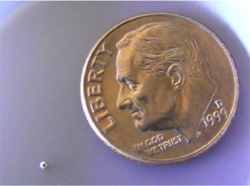CFL's are energy-saving light bulbs that use between one third and one fifth of the energy, and have between eight and fifteen times the life, of an incandescent bulb. In both homes and commercial buildings, CFLs are substantially more cost effective than incandescent lamps.
At the end of this post you can find a list of different CFLs and what they're best used for.
Are CFL's dangerous?
You may have heard about mercury in CFLs. Mercury is a toxic element that is found in older thermometers and thermostats, among other things. If CFLs are so eco-friendly, why do they have mercury? CFLs contain between 1-5 mg of mercury, depending on the company. The average amount of mercury in a thermometer is 500mg, over 100x more than the CFL.
 |
| The amount of mercury in a typical CFL. |
Based on this information, we can see that CFLs can save money, energy, and keep pollution from our environment, when compared to incandescent bulbs. For more info visit these links
What if your CFL breaks? Check out an article here about proper disposal.
Those swirly bulbs
Most people know CFLs as "those swirly bulbs". Originally, CFLs almost always came in that characteristic spiral shape. Now, however, you can find almost any shape and style of CFL to fit your existing lamps, fixtures, and even pretty ones over the bathroom mirror.
Spiral Lamps:
Often called the "swirly" bulb, this lamp casts light similarly to incandescent bulbs and is the most popular of the incandescent bulbs.
Twin Tube Lamps:
This CFL has two parallel tubes. These are best used for certain lamps, task lights, recessed ceiling lights, and wall lights.
Quad Tube Lamps:
With four tubes, this lamp gives about the same light as the twin tube, but is hall the length. This type is then good for similar, but smaller fixtures that the twin tubes are used for.
Triple Blax Lamps:
These bulbs generate more light and are smaller than the twin and quad lamps. They are commonly used in fixtures designed for incandescent bulbs, such as table lamps.
F Lamps:
F lamps have two twin tubes, but are aligned top to bottom instead of side to side like a Quad tube making the shape of the bulb resemble and F. This type of CFL is commonly used for task lights and low profile recessed fixtures.
Circular (Circline) Lamps:
These are the CFL version of the circular fluorescent lights. These come in both cool and warm light so double check so you get what you want!
You can also find more decorative options, some that look like traditional incandescent bulbs, flood lights for outdoors, and more.
You can also find more decorative options, some that look like traditional incandescent bulbs, flood lights for outdoors, and more.
written by Roxanna Shohadaee



As this post states, CFLs do contain mercury, but they are a better solution, both economically and environmentally, than incandescent bulbs. The mercury is not high in quantity, however, it is still important for consumers to realize that they require special handling. The mercury vapor can be detrimental to handlers' health—from those involved with handling new bulbs to people involved with storing, packaging and shipping used lamps. Mercury vapor, which can be absorbed through the skin or inhaled, can cause neurological damage, and when it gets into water, it can enter the food chain through fish. Read more about the dangers of mercury exposure here: http://vaporlok.blogspot.com/2010/05/preventing-health-and-safety-hazards.html.
ReplyDeleteIf a bulb is broken, it should be properly cleaned up, and if burned out, properly recycled—it should not be disposed of in landfills. To reduce the risk for mercury vapor exposure, CFLs and fluorescent lamps should be safely handled, stored and transported to recycling facilities in a package that is proven to effectively contain hazardous mercury vapor. Find out more about how to minimize environmental risks and safely package CFLs here: http://vaporlok.blogspot.com/2010/05/layers-of-protection-packaging-used.html
If a bulb breaks, consumers can learn more about clean-up procedures here: http://www.epa.gov/cfl/cflcleanup-detailed.html